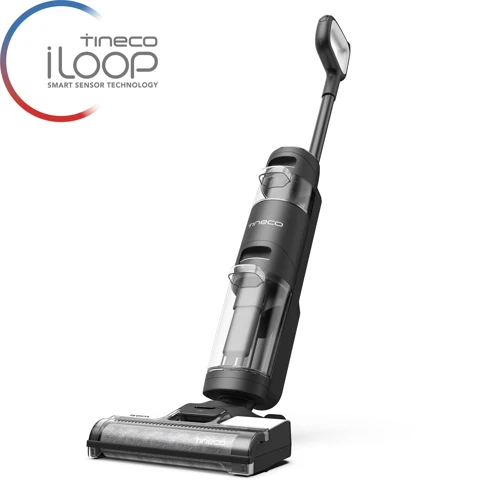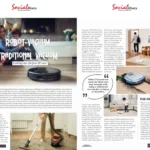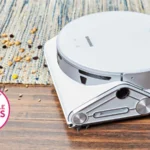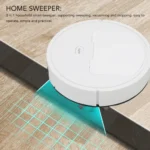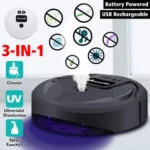Vacuum cleaners have come a long way from being simple devices that only clean floors. The latest trend in the market is the emergence of smart vacuum cleaners that are revolutionizing the way we clean and maintain our living spaces. These machines are not just equipped with advanced technology, but are also allergy and asthma-friendly. But what exactly makes these devices so special? What are the key features that set them apart from traditional vacuum cleaners? And how do they help individuals who suffer from allergies and asthma? In this article, we’ll explore the answers to these questions and more, uncovering the future of allergy and asthma-friendly vacuum cleaners with smart app controls.
What are Smart Vacuum Cleaners?
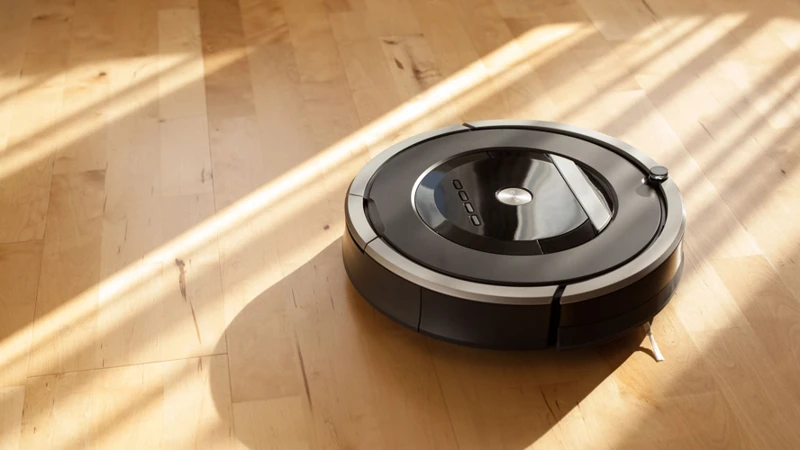
Are you tired of constantly sneezing and coughing due to allergy and asthma triggers? Smart vacuum cleaners might just be the solution you’ve been looking for. Using advanced technology and innovative features, smart vacuum cleaners promise to make cleaning easier and more efficient than ever before. With the ability to connect to apps and controls, such as the smart app controls for allergy and asthma, these vacuums not only eliminate dirt and dust but also reduce allergens and pollutants in your home. Let’s dive deeper into what exactly smart vacuum cleaners are and how they can benefit both allergy sufferers and asthmatics.
How are they different from traditional vacuum cleaners?
Smart vacuum cleaners are a new generation of cleaning devices that are rapidly gaining popularity among the masses. Here are some ways they differ from traditional vacuum cleaners:
- Control: Unlike traditional vacuum cleaners, smart vacuum cleaners are controlled through smart apps that you can download on your smartphone, making it more convenient and easy to use.
- Automation: Smart vacuum cleaners are capable of running on their own. You can even set a schedule when you want it to clean your floor or carpet. Traditional vacuum cleaners require human intervention at every step during the cleaning process.
- Efficiency: Smart vacuum cleaners come with advanced suction mechanisms, ensuring that no dust or dirt is left behind, making your house cleaner and safer for allergy and asthma sufferers. Traditional vacuum cleaners may not be as efficient, leaving behind some dust and dirt.
- Noise levels: Smart vacuum cleaners are designed to operate quietly so that they don’t disturb anyone else in the house. Traditional vacuum cleaners are often noisy and can be disturbing.
- Portability: Smart vacuum cleaners are often more compact and lightweight. They are also designed to be more flexible and can go into areas that traditional vacuum cleaners cannot.
Smart vacuum cleaners have been designed keeping in mind the needs of modern families. With the ability to clean any corner of your house, these vacuum cleaners are the perfect tool for busy people who don’t have time to clean. The efficiency and performance of these cleaners make them the best choice for allergy and asthma sufferers.
What are their benefits?
Smart vacuum cleaners have several benefits that make them highly desirable in comparison to traditional vacuum cleaners. Here are some of the benefits of smart vacuum cleaners that set them apart:
- Efficiency: The automated cleaning process ensures that no part of the room is left uncleaned. This feature makes smart vacuum cleaners highly efficient as they save time and effort in cleaning the whole house.
- Allergy and Asthma-Friendly: Smart vacuum cleaners equipped with HEPA filters and advanced technology is an ultimate solution for people suffering from allergies and asthma. These cleaners trap even the tiniest allergens, dust mites, pet dander and bacteria in the filters, making it safe for people with respiratory disorders.
- Convenience: With the smart app controls, smart vacuum cleaners become more convenient for users. Users can control and monitor the cleaning process through the mobile app from anywhere.
- Quieter cleaning: Another great advantage of smart vacuum cleaners is that they have quieter operation compared to traditional ones. The advanced technology ensures that it operates with low noise and doesn’t disrupt your everyday life.
- Saves time: It saves considerable time and effort as users can set up the cleaning time and forget about it. The vacuum cleaner will work on its own, and the house will be cleaned by the time you get back home.
Smart vacuum cleaners are also environment-friendly as they require less energy, making them ideal for people who want to reduce their carbon footprint. These benefits show us that smart vacuum cleaners have a lot to offer, and they are the future of home cleaning. If you are interested in finding out more about smart vacuum cleaners and the efficiency of smart app control, check out our efficient smart vacuum app control article.
What’s new with the Smart Vacuum Cleaners?

In the fast-paced world of technological advancements, no appliance is safe from being upgraded and enhanced. Smart vacuum cleaners are no exception to this rule. With recent innovations in technology, smart vacuum cleaners have undergone significant changes that have made them more efficient, powerful, and user-friendly than ever before. In this section, let’s take a closer look at what’s new and exciting with these futuristic cleaning devices.
Technology behind making these vacuum cleaners
Smart vacuum cleaners are the latest technology designed to make your cleaning experience easier and more efficient. They are created with a unique blend of features that make them not only easy to use but also highly effective in removing dirt and dust particles from various surfaces. Here are some of the technologies behind making these advanced vacuum cleaners:
- Artificial Intelligence: Most smart vacuum cleaners employ artificial intelligence (AI) technology to optimize their cleaning ability. Through algorithms, they can learn and adapt to specific cleaning and navigation patterns with consistent use. This means that the more you use your smart vacuum cleaner, the smarter it becomes and the better it can clean your home.
- Multiple Sensors: Smart vacuum cleaners have multiple sensors integrated into their design that allows them to detect and avoid obstacles during cleaning. Some of these sensors detect different types of flooring, adjust suction and power levels, and help the vacuum cleaner navigate easily around furniture and other obstacles. This allows these vacuums to clean even the hardest-to-reach places with precision.
- Smart Navigation: Smart navigation features are included in most smart vacuum cleaners, and they help to map the home’s layout and areas that require cleaning. A cleaning path is then created, and the vacuum cleaner follows this path to ensure that every part of the floor is cleaned effectively. They can also be controlled through a mobile app, allowing users to create virtual boundaries or highlight specific areas that need more attention.
- Remote Control: Smart vacuum cleaners come with remote control through a designated mobile app. You can control the vacuum cleaner, set schedules, and monitor cleaning performance remotely from your phone. This level of convenience and control saves time and increases overall efficiency in cleaning.
- Voice Command: Smart vacuum cleaners can be paired with a home assistant smart speaker, such as Google Home or Amazon Echo, allowing users to control and monitor their vacuum cleaner by voice command. This feature is perfect for people who have limited mobility and want a hassle-free cleaning experience.
These are some of the technologies employed in making smart vacuum cleaners. Their ability to learn, adapt, and optimize the cleaning process, coupled with their convenience and ease-of-use, make them a crucial addition to any home. By investing in a smart vacuum cleaner, you are not only investing in a cleaner home but in a more efficient and convenient cleaning experience.
How it helps allergy sufferers?
Smart vacuum cleaners are equipped with advanced technology to help people with allergies to breathe a cleaner and fresher indoor air. Let’s explore how these smart vacuum cleaners can help allergy sufferers in detail in the table below:
| Features | How it helps allergy sufferers |
|---|---|
| HEPA Filters: | High-Efficiency Particulate Air (HEPA) filters are designed to capture harmful particles such as pet dander, dust mites, pollen, and other allergens. This technology ensures that the vacuum cleaner traps 99.97% of allergens from carpets, floor, and upholstery. This improved air quality is especially beneficial for people with allergies and asthma. |
| Automated Cleaning Process: | Smart vacuum cleaners come with an automated cleaning process that saves the user valuable time and effort. This process reduces allergen exposure during the cleaning process by not kicking up dust and debris as traditional vacuum cleaners do. |
| Advanced Suction Mechanism: | Many smart vacuum cleaners use advanced suction mechanisms that are specifically designed to pick up allergens. This technology can remove unseen dust particles within the carpet fibers, even the ones that are embedded within the fibers. |
| Convenient Apps and Controls: | Smart vacuum cleaners come with convenient apps and controls that make it easy for users to regulate the vacuum cleaner. Users can easily turn the vacuum cleaner on and off, schedule the cleaning sessions, and even adjust the suction power. This technology ensures that the vacuum cleaner is working at optimum efficiency, making it easier to maintain a cleaner indoor air quality. |
Smart vacuum cleaners have several features that make them a great choice for people with allergies. By using HEPA filters, automated cleaning processes, advanced suction mechanisms, and convenient apps and controls, smart vacuum cleaners provide a cleaner and healthier indoor air quality, helping allergy sufferers breathe easier.
How it helps asthmatics?
Smart vacuum cleaners have revolutionized the way we clean our homes, providing a range of advanced features that are particularly beneficial for asthmatics. In this section, we will look at some of the key ways in which these cutting-edge devices can help asthmatics breathe easier.
Reducing Exposure to Allergens: Asthma is a condition that is often triggered by allergens such as pollen, pet dander, and dust mites. Smart vacuum cleaners are designed to help minimize exposure to these allergens by removing them from the air and surfaces in your home. With their advanced suction mechanisms and HEPA filters, they are highly effective at removing even the smallest particles of dust and dirt from carpets, furniture, and other surfaces.
Monitoring Air Quality: Another key benefit of smart vacuum cleaners for asthmatics is their ability to monitor air quality. Many modern devices come equipped with sensors that can detect changes in air quality and alert users when levels of pollutants or allergens are too high. This can be extremely useful for asthmatics, as it allows them to take evasive action and adjust their environment as necessary.
Providing Improved Indoor Airflow: Asthma sufferers often experience problems with poor airflow in their homes, which can exacerbate symptoms and make it harder to breathe. Smart vacuum cleaners are designed to provide improved indoor airflow by removing dust and other particles from the air and ensuring that clean, fresh air is circulated throughout your home. This can help to reduce symptoms and improve overall respiratory health.
To sum up, smart vacuum cleaners can help asthmatics in a number of ways, from reducing exposure to allergens, to monitoring air quality, and improving indoor airflow. By investing in a high-quality device with advanced features, you can create a cleaner and healthier home environment that is more conducive to good respiratory health.
| Benefit | Description |
| Reducing Exposure to Allergens | Smart vacuum cleaners are highly effective at removing even the smallest particles of dust and dirt from carpets, furniture, and other surfaces, thereby minimizing exposure to allergens such as pollen, dust mites, and pet dander. |
| Monitoring Air Quality | Smart vacuum cleaners come equipped with sensors that can detect changes in air quality and alert users when levels of pollutants or allergens are too high, which is particularly helpful for asthmatics who need to be mindful of their environment. |
| Providing Improved Indoor Airflow | Smart vacuum cleaners can help to improve indoor airflow by removing dust and other particles from the air and ensuring that clean, fresh air is circulated throughout your home, thereby reducing symptoms and improving overall respiratory health. |
Top Features of Allergy and Asthma-Friendly Vacuum Cleaners with Smart App Controls
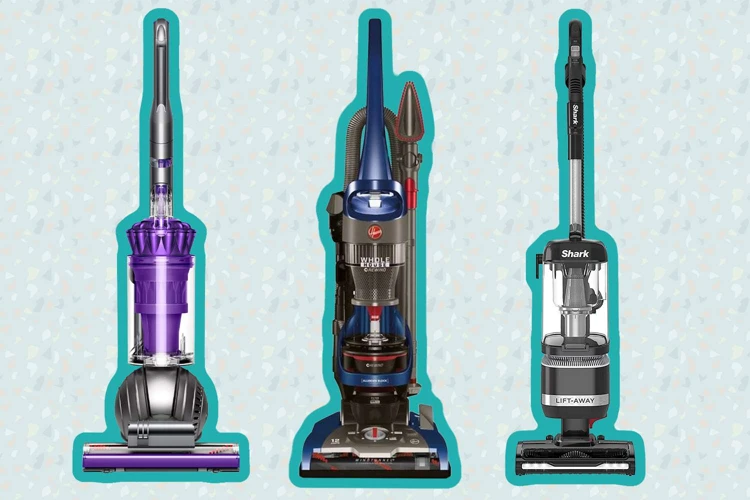
Investing in a high-quality vacuum cleaner is essential to maintaining a clean and healthy living environment, especially for people with allergies and asthma. The good news is that with the advent of modern technology, we now have allergy and asthma-friendly vacuum cleaners with smart app controls that make cleaning a breeze. These vacuum cleaners come with a range of features that contribute to their effectiveness and ease of use. In this section, we will explore the top features of these innovative vacuum cleaners that cater to the needs of those with allergies and asthma. Read on to discover how these features can help you keep your home clean and free of allergens.
HEPA Filters
HEPA filters are a vital aspect to consider when it comes to choosing the right allergy and asthma-friendly vacuum cleaner. HEPA stands for High-Efficiency Particulate Air, and these filters are designed to capture even the smallest particles, including pollen, dust mites, pet dander, and other allergens. Here are some crucial points to keep in mind when considering HEPA Filters:
- High-Efficiency: HEPA filters can capture up to 99.97% of airborne particles that are as small as 0.3 microns. This is the minimum efficiency standard set by the US Department of Energy.
- Cost: It’s important to note that HEPA filters may come at an additional cost compared to regular filters, but they are worth the investment as they provide superior air filtration.
- Maintenance: Be sure to check the specifics of the HEPA filter maintenance, how often it needs to be replaced, and the cost of replacement filters.
- Compatibility: Check if the replacement filters available for your vacuum cleaner are compatible with HEPA filters.
Investing in vacuum cleaners with HEPA filters can significantly improve the air quality in your home, and it’s a crucial consideration for those suffering from allergies and asthma. Keep in mind the above points, and choose the right vacuum cleaner that caters to your specific needs.
Convenient Apps and Controls
Smart vacuum cleaners bring a lot of convenience and control with them. They are designed to offer control and customization to the user with the help of convenient apps and controls. Some of the convenient features of these vacuums include:
- Integrated Smart Apps: Many smart vacuum cleaners now come with integrated apps that can be downloaded on your phone. These apps provide users with real-time updates and notifications about the status of the vacuum cleaner. Some of these apps also allow users to control the vacuum cleaner remotely, which means you can start or stop cleaning the room when you’re not even there.
- Touch Screens: Some smart vacuum cleaners come with touch screens that allow you to control the settings with ease. This makes it easy for users to control the suction power, schedule cleaning times, and view the cleaning history of the vacuum cleaner.
- Voice Control: Some vacuum cleaners are now integrated with voice assistants like Alexa and Google Assistant. This makes it easy for users to control the vacuum cleaner with their voice. For instance, users can say “Alexa, turn on the vacuum cleaner” and the vacuum cleaner will start cleaning the room.
- Multi-Room Mapping: With the help of advanced sensors and mapping technology, some smart vacuum cleaners can now map multiple rooms and store the map for future use. This means that when the user wants to clean a specific room, the vacuum cleaner will automatically detect it and start cleaning without any additional input from the user.
- Customized Cleaning: Smart vacuum cleaners allow users to customize the cleaning preferences according to their needs. For instance, users can set the suction power to low or high depending on the type of floor or carpet they are cleaning. They can also specify which areas of the room they want to clean and which areas they don’t want to clean.
The convenience and control offered by smart apps and controls make them an ideal choice for those looking for an easy and hassle-free cleaning experience. It is important to note that different vacuum cleaners come with different features, so it is important to choose a vacuum cleaner that suits your cleaning needs and preferences.
Wifi Connectivity
One of the most significant features of smart vacuum cleaners is their ability to connect to Wi-Fi. Wi-Fi connectivity provides numerous benefits that cannot be achieved with traditional vacuum cleaners. Table 1 highlights some of the advantages and drawbacks of having Wi-Fi connectivity in your smart vacuum cleaner.
| Advantages | Drawbacks |
|---|---|
| Remote control-ability | Initial higher cost |
| Convenient scheduling | Less privacy |
| Real-time alerts about cleaning progress and maintenance | Complicated setup |
| Easy firmware updates | Potential connectivity issues |
Having remote control capability allows you to control your smart vacuum cleaner’s functions from your phone. Table 2 summarizes some functions you can control remotely.
| Function | What it does |
|---|---|
| Start/Stop | Start and stop cleaning cycle remotely |
| Scheduling | Schedule cleaning cycles according to your preferences |
| Mapping | View cleaning progress of your smart vacuum cleaner on your phone |
| Notifications | Receive notifications when cleaning is completed or when maintenance is required |
As with any technology, there are some drawbacks to consider before investing in a smart vacuum cleaner with Wi-Fi connectivity. One of the primary drawbacks is that it may come with an initial higher cost. Also, Wi-Fi connectivity means you will be trading some privacy in exchange for the ability to control your vacuum cleaner remotely. Additionally, setting up Wi-Fi connectivity can be complicated, and there might be potential issues in connecting your smart vacuum cleaner to your network.
Wi-Fi connectivity is a powerful feature that brings a new level of convenience and control to smart vacuum cleaners. Table 1 and Table 2 provide an overview of the advantages and drawbacks of adding Wi-Fi connectivity to your smart vacuum cleaner. When buying a smart vacuum cleaner with Wi-Fi connectivity, it is essential to compare features carefully, consider the associated costs, and ensure it meets your requirements.
Automated Cleaning Process
One of the most impressive features of allergy and asthma-friendly vacuum cleaners with smart app controls is their automated cleaning process. This feature allows the vacuum cleaner to operate without human intervention, making cleaning a stress-free task.
How does the automated cleaning process work?
These vacuum cleaners come equipped with sensors that detect the floor’s surface, furniture, and obstructions. The sensors send information to the microprocessor, which signals the machine on the direction of movement and the suction power required to clean the surface. This way, the vacuum cleaner covers all areas of the room, leaving no particles behind.
Benefits of an automated cleaning process
An automated cleaning process has several advantages, including:
| Advantage | Description |
|---|---|
| Saves Time | The machine works on its own, freeing up your time to do other tasks. |
| Efficient Cleaning | The sensors detect all areas that require cleaning, ensuring that no spot is left undone. |
| Conserves Energy | The automated process conserves the vacuum cleaner’s energy by using only the required suction power to clean the surface. The vacuum cleaner also automatically turns off when the cleaning process is complete. |
| Convenient Cleaning | You can schedule the automated cleaning process even when you’re not around using the convenient app or control features. |
Drawbacks of an automated cleaning process
While the benefits of an automated cleaning process are many, there are a few potential downsides to consider:
| Disadvantage | Description |
|---|---|
| Requires Clear Space | The vacuum cleaner requires clear space to clean efficiently. Cluttered rooms with lots of furniture or objects on the floor may result in less clean surfaces. |
| System Malfunctions | Like any other electronic device, an automated vacuum cleaner can malfunction, causing problems with the cleaning process. Regular maintenance and cleaning are necessary to prevent any system malfunctions. |
| No Human Touch | While the automated cleaning process is convenient, there is no human touch involved in the process. It may not clean surfaces that require a human touch, such as corners or crevices. |
The automated cleaning process is a fantastic feature of allergy and asthma-friendly vacuum cleaners with smart app controls. It saves time, is energy-efficient, and provides efficient cleaning. However, it is essential to consider the drawbacks and ensure that the room allows for effective cleaning.
Advanced Suction Mechanism
When it comes to selecting a smart vacuum cleaner for allergy and asthma sufferers, an advanced suction mechanism is a crucial feature to look out for. These advanced suction mechanisms ensure the removal of even the tiniest of particles from carpets, floors, and upholstery. Here are some key details to keep in mind when it comes to the suction mechanism of smart vacuums:
- Varying suction modes: Many smart vacuums offer different suction modes that offer variable suction power depending on the surface being cleaned. This feature ensures that you can easily clean different surfaces with varying levels of suction power.
- Multiple brush heads: The suction mechanism of smart vacuums often comes with multiple brush heads that help to clean surfaces effectively. These brushes include a motorized brush for carpets, a dusting brush for upholstery, and crevice tools for tight spaces.
- Adjustable suction power: Smart vacuums come with adjustable suction power to suit various surfaces and cleaning requirements. This feature helps save energy while ensuring thorough and efficient cleaning.
- Brush-less motor: Many smart vacuums feature a brush-less motor that reduces noise levels while ensuring high suction power. These motors are also more durable and require less maintenance than traditional motors.
- Edge cleaning: Advanced suction mechanisms in some smart vacuums also feature edge cleaning capabilities that reach tight corners and edges in your home with ease, ensuring that every inch of your home is spotless.
With the advanced suction mechanisms of smart vacuums, you can rest assured that your carpets, floors, and upholstery are free from allergens and asthma triggers. The multiple brush heads, varying suction modes, and edge cleaning capabilities make these vacuums highly efficient and flexible. With an adjustable suction power, brush-less motor, and noise reduction capabilities, you can enjoy efficient cleaning and a peaceful home environment.
Low noise levels
One of the most common complaints about vacuum cleaners, even the Smart ones, is the noise they make. However, with the latest innovative technologies, manufacturers are designing high-performance vacuums with low noise levels.
What are Low Noise Levels?
The noise levels produced by vacuum cleaners are measured in decibels (dB). A typical vacuum cleaner produces about 70dB of sound. A Smart vacuum cleaner with low noise levels produces about 60 dB of sound or even lower.
Benefits of Low Noise Levels in Smart Vacuum Cleaners
A Smart vacuum cleaner with low noise levels has several benefits, including:
| Benefits of Low Noise Levels in Smart Vacuum Cleaners | Explanation |
|---|---|
| Less Disruption | The low noise levels reduce the disruption caused by cleaning, making it possible to vacuum during odd hours without disturbing other people in the house or the neighbors. |
| Peaceful Cleaning Experience | The low noise levels make the cleaning experience more peaceful and relaxing. |
| Better Concentration | The low noise levels enable people to concentrate on other activities, such as watching television, working, or even sleeping while the vacuum cleaner does its job. |
| Less Stressful | The low noise levels make vacuuming less stressful, especially for people with anxiety disorders or sensory sensitivities. |
How do manufacturers achieve low noise levels in Smart Vacuum Cleaners?
Manufacturers use various technologies to reduce the noise levels of their vacuum cleaners. Some of these technologies include:
| Technologies used to achieve low noise levels in Smart Vacuum Cleaners | Explanation |
|---|---|
| Insulation Materials | Manufacturers use special insulation materials to reduce noise produced by the vacuum’s motor and spinning brushes. |
| Noise-cancelling Technology | Some Smart vacuum cleaners come with noise-cancelling technology that reduces ambient noise levels while cleaning. |
| Improved Design | Manufacturers redesign their vacuum cleaners to optimize the airflow and reduce turbulence, which can lead to noise production. |
| Better Motors | Manufacturers use better motors that produce less noise while maintaining the vacuum’s suction power. |
Conclusion
Smart vacuum cleaners with low noise levels offer several benefits, including less disruption, a peaceful cleaning experience, better concentration, and reduced stress levels. Manufacturers use insulation materials, noise-cancelling technology, improved design, and better motors to reduce noise production in their vacuum cleaners. When choosing a Smart vacuum cleaner, it is essential to consider the noise levels to ensure you have a quiet and efficient cleaning experience.
Increased Efficiency
One of the most important factors that sets smart vacuum cleaners apart from traditional vacuum cleaners is their increased efficiency. Smart vacuum cleaners have been designed to clean your home with minimal effort while ensuring maximum cleaning efficiency. Here are some key features that contribute to their increased efficiency:
- Intelligent Navigation: One of the primary reasons for the increased efficiency of smart vacuum cleaners is their intelligent navigation system. The navigation system allows the vacuum cleaner to map out the room, identify obstacles, and plan the most efficient cleaning path. This results in minimal wasted movement and coverage of every inch of the floor.
- Sensor Technology: Smart vacuum cleaners come equipped with a variety of sensors that allow them to detect dust, dirt, and debris on the floor. They can also detect obstacles and adjust their cleaning path accordingly. The sensors also enable them to detect changes in floor coverings and adjust their suction power accordingly for optimal cleaning performance.
- Advanced Suction Mechanism: Smart vacuum cleaners are equipped with powerful suction mechanisms that allow them to remove even the finest dust and allergens from carpets, rugs, and hard surfaces. These vacuums can pick up pet hair, dander, and other debris that could cause allergies and asthma, ensuring a clean environment for you and your family.
- Automated Cleaning: Smart vacuums come with automated cleaning features that allow you to schedule cleaning sessions in advance. This means you can set the vacuum to clean your floors automatically, at a specific time or day, even when you are away from home. This increases efficiency, frees up your time and ensures your home is clean at all times.
- Multi-surface Cleaning: A good smart vacuum cleaner is designed to be versatile enough to clean different surfaces. This means it can efficiently clean carpets, hardwood floors, tiles, and more, using the right cleaning attachments and suction power. This ensures that every inch of the house is effectively cleaned.
- Large Dustbin Capacity: Smart vacuums come with large capacity dustbins that can hold a significant amount of dust and dirt, so you do not need to keep emptying the bin every time you vacuum. This increases efficiency and reduces the time and effort required to clean your home.
The increased efficiency of smart vacuum cleaners can save you time, effort and provide relief for allergies and asthma. It is essential to look for a vacuum cleaner with these features so that you can enjoy clean and dust-free floors at home, without breaking a sweat.
Portability and Flexibility
When it comes to purchasing a smart vacuum cleaner, portability and flexibility are important factors to consider. You want a vacuum cleaner that is easy to move around and can adapt to different cleaning situations. Here are some key features that affect a vacuum cleaner’s portability and flexibility:
| Feature | Description |
|---|---|
| Weight | The weight of a vacuum cleaner is an important factor to consider, especially if you have to move it up and down stairs or from room to room. Look for a vacuum cleaner that is lightweight and easy to carry. |
| Cord Length | The length of the cord determines how far you can clean without having to switch to another power outlet. Look for a vacuum cleaner with a long cord if you have a large house or apartment. |
| Battery Life | If you choose a cordless vacuum, make sure that its battery life is long enough to clean your entire house on a single charge. Check if the manufacturer offers additional batteries that you can swap in for a longer cleaning time. |
| Maneuverability | A vacuum cleaner that is easy to maneuver around corners and furniture can save you a lot of time and effort. Look for a vacuum cleaner with a swiveling head and good steering for maximum flexibility. |
| Attachments | Attachments such as crevice tools and upholstery brushes make cleaning tight spaces and fabric surfaces a breeze. Look for a vacuum cleaner that comes with a variety of attachments to suit your different cleaning needs. |
| Storage | Finally, consider where you will store your vacuum cleaner. Look for a vacuum cleaner that is easy to store in a closet or under a bed, and that comes with a compact charging dock or wall mount. |
When you choose a vacuum cleaner with good portability and flexibility, you can clean your house with ease and convenience. Whether you have to clean tight spaces or large areas, a portable and flexible vacuum cleaner can make the job much more manageable.
What to Keep in Mind while Buying a Smart Vacuum Cleaner for Allergy and Asthma?
Choosing the right smart vacuum cleaner for allergy and asthma sufferers can be a daunting task. With so many options available in the market, it is essential to keep in mind certain features that can make a significant difference for people with allergies or asthma. In this section, we will explore some key points that you should pay attention to when looking for a smart vacuum cleaner that is suitable for allergy and asthma sufferers. By considering these factors, you can make an informed decision and ensure that your home remains a safe and healthy environment.
Check the Specifics of the HEPA Filters maintenance
When buying a smart vacuum cleaner for allergy and asthma sufferers, one of the essential factors to consider is the maintenance of HEPA filters. HEPA, which stands for High-Efficiency Particulate Air, is a type of filter that can capture tiny particles that traditional filters often miss.
Here are some specifics to keep in mind when checking the maintenance of HEPA filters:
- Frequency of replacement: As HEPA filters are designed to capture microscopic dust particles, they tend to clog quickly, leading to decreased suction power. It’s essential to check the manufacturer’s recommendation on how often the filter needs replacement.
- Cleaning method: Some HEPA filters are washable, while others require replacement. It’s essential to understand how to clean your filter and how much time and effort it will take. Some filters might require specific cleaning tools or detergents that might add to additional costs.
- Cost of Replacement: While washable filters might seem like a cheaper option, they might not last as long as replaceable ones. It’s essential to evaluate the costs of replacement filters and the frequency of replacement to avoid any unforeseen costs.
- Quality of Replacement: Not all replacement filters are made equal. It’s crucial to invest in a quality filter that meets the manufacturer’s specifications to ensure the vacuum maintains its suction power and usefulness.
By keeping these specifics in mind, you can ensure that your smart vacuum cleaner’s HEPA filter is always operating at its best, ensuring a clean and allergy-free home.
Know the Right Suction Power
When looking for a smart vacuum cleaner for allergy and asthma sufferers, it’s important to know the right suction power. The suction power of a vacuum cleaner determines how effective it is at picking up dirt, dust, and other allergens. It’s always better to choose a vacuum cleaner with a strong suction power, but it’s important to find the right balance.
Here are some important points to keep in mind when looking for the right suction power:
- Consider the types of floors: If you have mostly hardwood floors, you don’t need the same suction power as someone with wall-to-wall carpeting. A lower suction power is sufficient for hardwood floors, while a higher suction power is necessary for carpeting.
- Check the manufacturer’s recommendations: Most manufacturers will provide recommendations for the suction power based on the type of flooring and the model of vacuum cleaner. Check the manual or consult the manufacturer’s website for more information.
- Beware of too much suction: While a strong suction power is necessary for effective cleaning, too much suction can damage delicate surfaces like area rugs or curtains. Look for a vacuum cleaner with adjustable suction power to avoid any damage.
- Consider the size of your home: If you have a large home, you may need a stronger suction power to effectively clean all the rooms. Conversely, if you have a smaller home or apartment, a lower suction power may be sufficient.
- Think about the types of debris you need to clean: If you have pets, for example, you may need a stronger suction power to pick up pet hair and dander.
When looking for a smart vacuum cleaner for allergy and asthma sufferers, it’s important to find the right suction power for your specific needs. Consider the type of flooring in your home, the manufacturer’s recommendations, the size of your home, the types of debris you need to clean, and the possibility of too much suction. With these factors in mind, you can choose a vacuum cleaner that will effectively clean your home without causing any damage.
Check for Adequate Capacity
One important consideration when buying a smart vacuum cleaner for allergy and asthma sufferers is checking for adequate capacity. The last thing you want is to have to stop mid-cleaning session to empty the dustbin or replace the bag. So, before making a purchase, make sure to take note of the dustbin or bag capacity of the model you are considering.
Here are a few tips to keep in mind:
- Check the dustbin or bag capacity in liters or gallons, depending on the measuring system used by the manufacturer.
- Consider the size of your home and the frequency of your cleaning sessions when deciding on the capacity. For larger homes, a larger dustbin or bag capacity may be necessary to avoid frequent emptying.
- Look for models with an easily removable dustbin or bag for hassle-free disposal.
- Consider the type of debris you typically encounter. If you have pets or frequently clean up larger debris like leaves and twigs, you may need a larger capacity to avoid constantly stopping to empty the dustbin or bag.
- Some models have sensors that alert you when the dustbin or bag is full. This can be a helpful feature to prevent overfilling and reduce the risk of losing suction power.
By keeping these tips in mind and checking for adequate capacity, you can ensure that your smart vacuum cleaner is a reliable and efficient cleaning tool for allergy and asthma sufferers.
Consider the Noise Levels
When looking for a smart vacuum cleaner that is suitable for those with allergies and asthma, it is important to consider the noise levels. Nobody wants a loud, disruptive cleaning session, especially if you have children or pets at home. For some people with sensitivity to noise, high decibel levels can cause discomfort and lead to headaches or even hearing damage. It is advisable to choose a vacuum cleaner that produces minimal noise.
So, how can you determine the noise levels of a vacuum cleaner before purchasing it? One simple solution is to check the decibel (dB) rating of the product. The higher the decibel rating, the louder the vacuum cleaner will be. A vacuum cleaner with a decibel rating of between 60 and 65 dB is considered reasonably quiet. However, some of the latest models come with a decibel rating lower than 50 dB, which is almost silent and perfect for people who need a peaceful environment.
In addition to decibel ratings, it is also beneficial to ask for a demonstration of the vacuum cleaner before making a purchase. Hearing the noise level firsthand can help you make an informed decision. Some retailers offer a free demo of the vacuum cleaner in-store, or you can watch online review videos to get an idea of the sound levels of different models.
To sum it up, noise levels are an important aspect to consider when choosing a vacuum cleaner, especially if you plan to use it regularly in a household setting. Take the time to research and compare decibel ratings, and consider requesting a demonstration or watching reviews online to ensure you are choosing a vacuum cleaner with a noise level that suits your needs.
Look for an Adjustable height and flexible hose
When looking for the perfect allergy and asthma-friendly vacuum cleaner with smart app controls, it’s essential to consider the height and flexibility of the hose. This feature not only ensures ease of use but also affects the overall cleaning performance.
The benefits of an adjustable height and flexible hose
Having an adjustable height and flexible hose allows the vacuum cleaner to reach tight spaces, under furniture, and in areas that are difficult to clean. It is especially essential for individuals with allergies and asthma as it enables them to clean areas that may have accumulated dust and allergens, reducing their exposure to potential triggers.
Additionally, an adjustable hose makes it easier to control the vacuum cleaner, reducing the risk of injuring your back, shoulders, or arms during cleaning. The flexibility of the hose provides better maneuverability, ensuring you can reach every nook and cranny.
Factors to consider
When looking for a vacuum cleaner with adjustable height and a flexible hose, there are several factors to consider, such as:
| Factor | Importance |
| The length of the hose | It determines how far you can reach and if you can clean taller spaces with ease. |
| The flexibility of the hose | If the hose is too stiff, you may not be able to bend it to clean specific areas. |
| The width of the hose | A wider hose may mean better suction power and coverage but can be difficult to use in tight spaces. |
| The handle and grip | The handle should be comfortable to hold and allow for better control during cleaning. |
Conclusion
When looking for the perfect allergy and asthma-friendly vacuum cleaner with smart app controls, it’s crucial to consider the height and flexibility of the hose. A good adjustable hose will make cleaning easier, especially when trying to clean hard-to-reach areas. Pay attention to the different factors that make up the hose to ensure you choose a vacuum cleaner that works best for you.
Compare Prices and Offers
One of the most important factors to consider before buying any appliance is the price. When it comes to purchasing a smart vacuum cleaner for allergy and asthma sufferers, it is essential to compare prices and offers in order to find the most suitable option for your budget and needs.
Here are some tips to follow while comparing prices and offers:
- Check various online stores and websites that offer smart vacuum cleaners with allergy and asthma-friendly features.
- Compare the prices of the different models that meet your requirements and needs.
- Look for any discounts, sales or promotional offers that can help you save money on your purchase.
- Consider any additional costs that may apply to the vacuum cleaner, such as shipping or handling fees.
- Read reviews or ask for recommendations from experts and other users who have already bought and used the smart vacuum cleaners that you are interested in.
By comparing prices and offers, you can make a more informed decision on which smart vacuum cleaner to buy for your home. Remember to keep in mind that the ultimate goal is to find a vacuum cleaner that is capable of effectively cleaning your home and improving your indoor air quality while also being affordable and within your budget.
So, take your time, do your research, and compare prices and offers before making your final purchase.
Conclusion
In conclusion, it’s clear that the future of vacuum cleaners is all about smart technology and allergy/asthma-friendly features. With the introduction of smart app controls, vacuuming has become easier and more efficient than ever before.
HEPA filters have been essential in filtering out allergens and pollutants from the air, making it safe to breathe in your home.
Convenient apps and controls make the process of vacuuming less of a hassle, and wifi connectivity ensures that you can control your vacuum from anywhere, at any time.
The automated cleaning process ensures that your home is always clean without you having to lift a finger.
Advanced suction mechanisms and low noise levels provide a more powerful and quieter cleaning experience.
Increased efficiency, portability, and flexibility make it easier to clean tight spaces and multiple surfaces.
When buying a smart vacuum cleaner, it’s important to consider the specifics of the HEPA filter maintenance, the right suction power, adequate capacity, noise levels, adjustable height, flexible hose, and price.
Overall, smart vacuum cleaners with allergy and asthma-friendly features are the future of home cleaning. With the latest technology and advanced features, it’s now easier than ever to keep your home clean and free from allergens and pollutants. They make your life easier and provide a healthier living environment for you and your family. So, invest in a smart vacuum cleaner today and experience the cleaning revolution for yourself!
Frequently Asked Questions
How do Smart Vacuum Cleaners work?
Smart Vacuum Cleaners have sensors and cameras that allow them to navigate around a room while cleaning. They use suction power to clean and filter the air through HEPA filters that capture allergens like pet dander and pollen.
Is it worth investing in a Smart Vacuum Cleaner?
If you are an allergy or asthma sufferer, a smart vacuum cleaner is definitely worth investing in. It offers advanced features and technology designed to improve your breathing and keep your home free from allergens.
What are the benefits of HEPA filters on Smart Vacuum Cleaners?
HEPA filters are designed to trap small allergen particles like dust mites, pollen, and pet dander, making sure they remain inside the vacuum cleaner instead of being released into the air you breathe.
Can Smart Vacuum Cleaners be controlled using smartphone apps?
Yes, Smart Vacuum Cleaners have smartphone apps that allow you to control the cleaner from anywhere, set cleaning schedules, and choose specific areas to clean. This makes the cleaning process more convenient and manageable.
Are Smart Vacuum Cleaners noisy?
Most Smart Vacuum Cleaners come with a noise level of around 60-70 decibels, which is usually quieter than traditional vacuum cleaners. However, it’s advisable to check product specifications before purchasing.
What is the importance of automated cleaning processes in Smart Vacuum Cleaners?
Automated cleaning processes make using Smart Vacuum Cleaners easier and more efficient. They allow the cleaner to clean rooms without being manually operated, saving energy, and time for you.
How do Smart Vacuum Cleaners benefit asthmatic individuals?
Smart Vacuum Cleaners are equipped with HEPA filters and advanced suction mechanisms that remove allergens, making the air cleaner and safer to breathe. This is especially important for individuals with asthma, who are more susceptible to various allergens and irritants.
What should I look for in a Smart Vacuum Cleaner with app controls?
When looking for a Smart Vacuum Cleaner with app controls, it is important to check for features such as HEPA filters, Wi-Fi connectivity, automated cleaning processes, and flexible hose. Additionally, check for noise levels and capacity.
Do all Smart Vacuum Cleaners come with HEPA filters?
No, not all Smart Vacuum Cleaners come with HEPA filters. It’s important to check product specifications to ensure it has HEPA filters, as they are beneficial for individuals suffering from allergies or asthma.
What makes Smart Vacuum Cleaners more efficient than traditional vacuum cleaners?
Smart Vacuum Cleaners are more efficient than traditional vacuum cleaners because they use advanced technology such as sensors, cameras, and automated cleaning processes. They are also designed to capture small allergen particles, making the air cleaner and safer to breathe.
